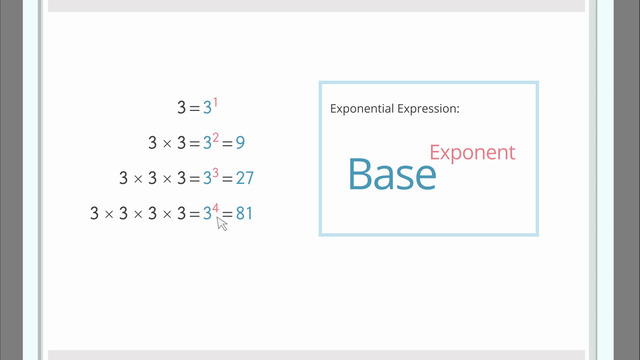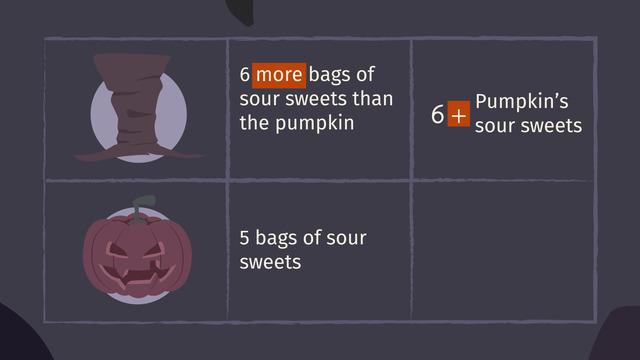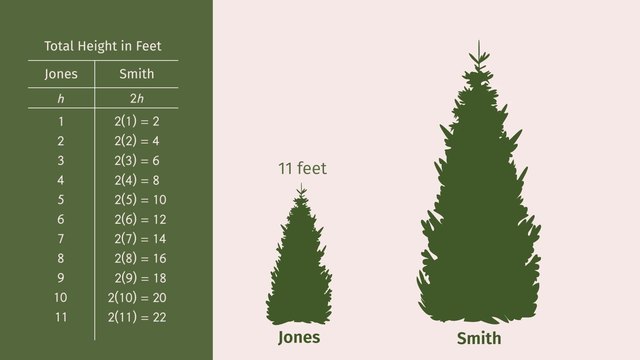Writing and Evaluating Expressions with Exponents


Basics on the topic Writing and Evaluating Expressions with Exponents
Writing and Evaluating Expressions with Exponents
Exponents are a critical component of algebra and are essential for simplifying and solving mathematical expressions efficiently. They provide a shorthand way of expressing repeated multiplication and significantly streamline the representation and calculation of large numbers. By understanding exponents, students can unlock new levels of mathematical proficiency and tackle more complex problems with confidence.
An exponent is a small numeral, known as the power, placed to the upper right of a base number, indicating how many times the base number is to be multiplied by itself. The expression $5^{2}$, for instance, means that the base, $5$, is used twice in multiplication: $5 \times 5$.
Writing Expressions with Exponents – Explanation
When it comes to writing expressions using exponential notation, it's crucial to understand the basic rules and how they can be applied to represent multiplication and division succinctly. Expressions with exponents can include positive powers, negative powers, and even powers of powers.
Evaluating Expressions with Exponents – Example
Evaluating expressions with exponents requires careful adherence to the order of operations. By following theorder of operations, you ensure accurate calculations. Let's evaluate the expression $2^{3} \times (2 + 3)$. First, calculate the exponent: $2^{3} = 8$. Then add the numbers inside the parentheses: $2 + 3 = 5$. Finally, multiply the results: $8 \times 5 = 40$.
Writing Expressions with Exponents – Application
Writing Expressions with Exponents – Summary
Key Learnings from this Text:
- Exponents simplify the representation of repeated multiplication.
- Positive exponents indicate the number of times a base is multiplied by itself.
- Negative exponents represent division or taking the reciprocal of the base.
- Writing and evaluating expressions correctly involves following the rules of exponents and order of operations.
Continue practicing writing and evaluating expressions with exponents to solidify your understanding of this fundamental math concept.
Writing Expressions with Exponents – Frequently Asked Questions
Transcript Writing and Evaluating Expressions with Exponents
Ever since she was a little girl, Leelee's wanted to be famous, but now that she’s a teenager, she realizes that she’s not especially good at anything. Poor Leelee, she realizes she may have an impossible dream, but one day, by complete accident, she made the most amazing video. Really, it's amazing! Leelee thinks that this video is her ticket to stardom and wonders, how long will it take until the video will go viral? Let’s help Leelee figure it out by using expressions with exponents. Leelee has a plan, as soon as her amazing video uploads, she'll send it to three friends and ask each friend to send it to three friends, and then ask each of those friends to send it to three of their friends, and so on, and so on. The video is really short, so Leelee figures that it should only take a minute for each of her three friends to watch the amazing video and then share it with three of their friends, and so on, and so on. Let’s write this information in a chart. After the first minute, her three friends will have watched the video, so that makes three views. After they each share it with three friends, that'll be another nine views. And, when those friends each share it with three more, that'll be another 27 views. Oh boy! By minute four, those 27 friends will each share with three of their friends, so that’s another 81 more views. Do you see a pattern? The number of views grows exponentially, so we can write each of these expressions using a base and an exponent. Let's take a look: 3 is equal to 31. 3 times 3 is the same as 3 squared, which we all know is 9, and 3 times 3 times 3 is equal to 3 cubed or 27, and so on, and so on. For each of these exponent expressions, the base, the number we multiply, remains the same. But the exponent, the number of times we multiply the base with itself, increases by one each time. What’s really neat is you can use this pattern to write an expression to calculate how many new views there will be any given minute. We can write this as 3 raised to the 'x' power, with ‘x’ representing the given minute. Leelee is impatient. She wants to be super famous ASAP. But what if she shares the video with five people, and they each share it with five people, and so on, and so on. At minute 10, how many new views will there be? If we multiply 5 by itself 10 times, that's the same as 5 raised to the 10th power! Calculating this out, there will be 9,765,625 people watching her video at minute 10. WOW! Leelee is really psyched! The video has finally finished uploading! She's gonna watch it so that she can be the very first viewer of this soon-to-be-famous video. Soooo cool! Just like Leelee predicted, the video went viral, and the fly is really famous, but Leelee - not so much.
Writing and Evaluating Expressions with Exponents exercise
-
Show how to write the given situation as an exonential expression.
HintsEach of the three friends recommends the video to another three friends.
Each indicates multiplication.
$a^n$ is a shorter way to write a multiplication: $a^n=a\times a\times ...\times a$, or $a$ multiplied by itself $n$ times.
If Leelee wants to know how many people are viewing her video in the fifth minute, she calculates $3^5=243$.
SolutionShe plans to send it to three friends, and after a minute she wants each of those friends to send it to another three friends each, and so on. Let's see what Leelee´s results should be:
- During the first minute, three people will view the video.
- During the second minute, $3\times 3$ people will view the video, which simplifies to $9$ people total.
- During the third minute, $3\times 3\times 3$ people will view the video, which simplifies to $27$ people total.
- During the fourth minute, $3\times 3\times 3\times 3$ people will view the video, which simplifies to $81$ people total.
- We can generalize this by saying that during the $x^{th}$ minute, $3^x$ people will view the video.
-
Express the following problem as a mathematical expression.
HintsWe have that $5^3=5\cdot 5\cdot 5\cdot 5$, while $3^5=3\cdot 3\cdot 3\cdot 3\cdot 3$.
Five friends who should send it to five friends each, gives us $5\times 5=5^2=25$ people viewing the video.
You finally have to multiply $25$ by $5$ once again: $25\times 5=125$.
Check this result with each of the given alternatives.
SolutionFirst, Leelee sends the videos to five friends. Then all of those friends send the video to five friends each. This leads to $5\times 5=5^2=25$.
Then, all of these $25$ people send the video to five friends each. So we finally get $5\times 5\times 5=5^3=125$ people viewing the video in the end.
-
Explain how to transform the word problems.
HintsHere you see how a video is shared after $1$, $2$, $3$, and $4$ minutes, when it is shared with three people in the first minute, and those three people share it with three more people in the second minute, and so on.
Keep the notation for exponents in mind:
- $3=3^1$
- $3\times 3=3^2$
- $3\times 3\times 3=3^3$
- $3\times 3\times 3\times3=3^4$
So after $3$ minutes, the video is shared with $3^3=27$ people.
SolutionIn each of the given examples you have to find the base as well as the exponent of a power:
Ladybugs
The video is shared with $4$ people. All of those share it with $4$ people each after one minute and so on. So after 5 minutes, we get $4\times 4\times 4...\times 4=4^5=1024$.
Butterflies
Leelee shares the video with $10$ people. All of those share it again with $10$ people each after one minute. And so on. Thus, after 4 minutes, we get $10\times 10\times 10...\times 10=10^4=10000$.
Grasshoppers
This time Leelee sends the video to $7$ people and asks them to send it out to $7$ people each after one minute. Then the video will be sent to $10$ people and so on. So after 6 minutes, we have $7\times 7\times 7...\times 7=7^6=117649$.
-
Find the right exponential expression.
HintsThe base of $a^n$ is $a$.
The exponent of $a^n$ is $n$.
For example, $4\times 4\times 4=4^3$.
SolutionNew Years Messages
She sends the messages to $6$ friends. After one hour each of those friends sends a message to another $6$ friends. So it's $6\times 6$. After another hour all of those $6\times 6$ friends send a message to $6$ friends each ... So we get $6^4$ messages sent after three hours.
Bacterium
A bacterium doubles after one period to $2=2^1$ bacteria. After another period there are $2^2$ bacteria. So we can see that $2^n$ there are bacteria after $n$ periods.
Giraffe Legs
First, determine the number of giraffes: $4$ giraffes in $4$ zoo exhibits leads to $4\times 4$ giraffes. Each of the giraffes has $4$ legs. So, in total we can count $4\times 4\times 4=4^3$ legs.
Mateo's Flyer
To promote his new taco bar, Mateo distributes flyers: first to $5$ people. All of those people distribute flyers to $5$ people each. After $4$ distributions $5^4$ flyers are given away.
-
Label the base as well as the exponent.
HintsThe exponent is the number of times you multiply the base by itself.
In general a power is given by $a^n$, where $a$ stands is the base of the power.
Keep the meaning of the corresponding positions in mind.
In the example beside, $7$ is the base while $5$ is the exponent.
SolutionIn general a power is given by $a^n$, where $a$ is called the base and $n$ is called the exponent.
You can read it as $a$ raised to the power of $n$.
-
Determine the corresponding expression.
HintsThe volume of any rectangular prism is given by
width $\times$ length $\times $ height.
You can simplify as follows:
$(3x)\times(2x)\times(4x)=(3)(2)(4)(x^3)=24x^3$.
Just multiply the coefficients.
The volume of a cube with the length $4$ is given by $64$.
SolutionThe volume of a cube can be determined by raising the side to the power of $3$. This leads to $a^3$.
The volume of a rectangular prism is given by width $\times$ length $\times $ height. Thus, we get $(3h)(4h)(h)=(3)(4)h^3=12h^3$.
The area of a square is given by the length squared: $s^2$.











